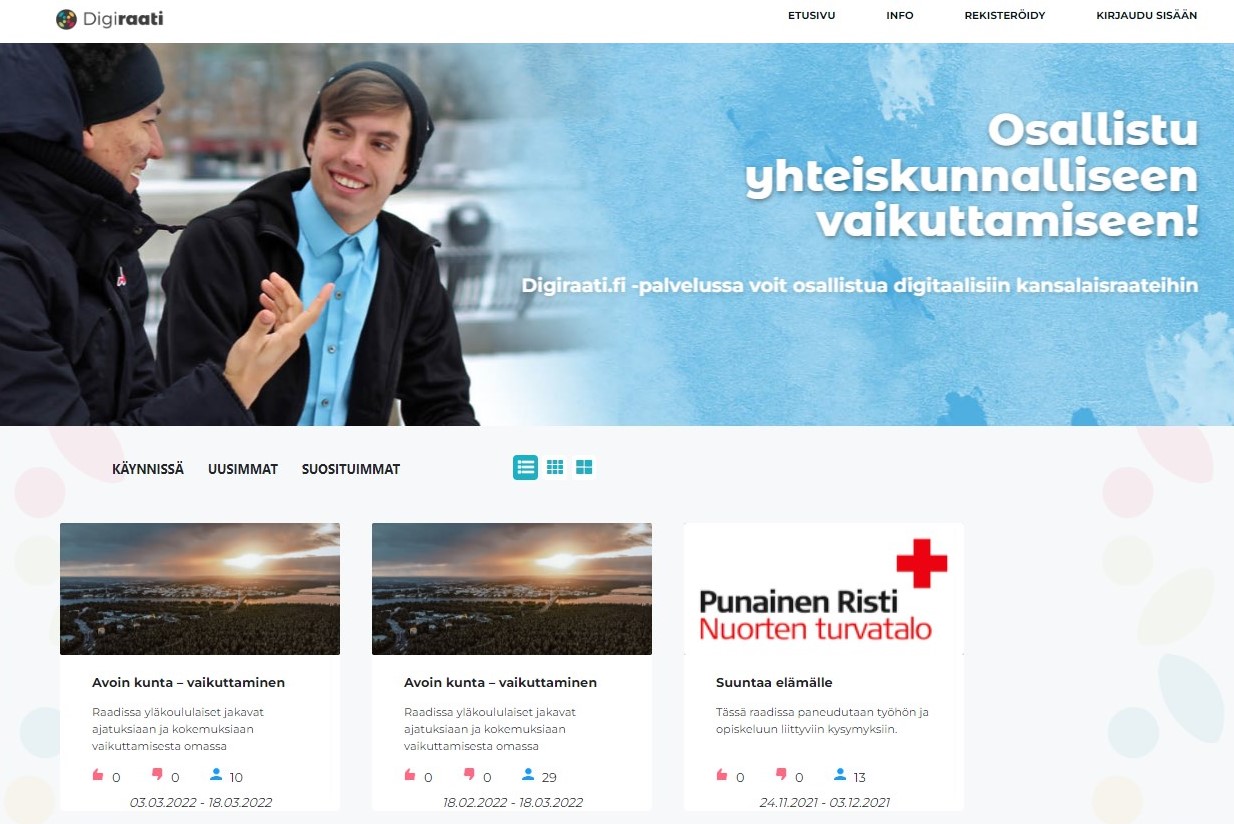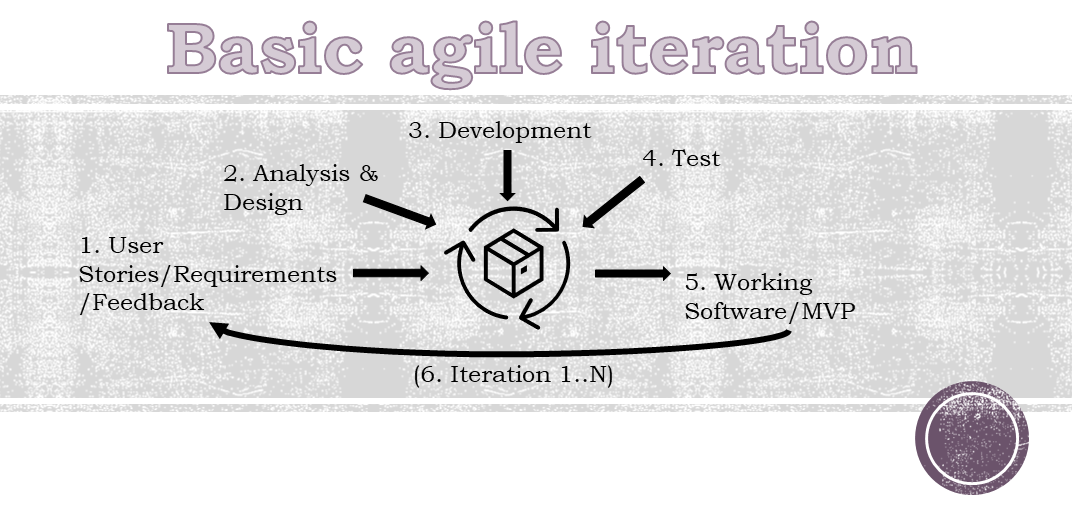Virtual Council – Digiraati in Finnish – is a web-based service aimed to enable and advance the societal participation of all youth between 15-29 years old. Originally, the prototype version was developed as a part of a multidisciplinary ALL-YOUTH research project at Tampere University back in 2019. The continuous improvement of this Virtual Council prototype has been going on until the Ministry of Justice recently launched the official production version of the service at their democracy platform (picture 1).

Developing and supporting a service like Virtual Council does not happen in a vacuum, but requires a lot of co-operation, background research of user needs and requirements. It’s also essential to be actively in touch with the stakeholders who operate the councils (during the development of the prototype, we have collaborated with Tampere Youth Services, Ministry of Environment, Finnish Red Cross, and many others) who in turn are engaged with the youth themselves. This enables the developers to have a meaningful feedback loop: what works and what doesn’t work, how the service is used and perhaps why someone doesn’t like to use it at all.

In autumn 2021, the focus shifted from the Virtual Council prototype (picture 2, and which we will come back later) to the production version, and an agile software development project was initiated. In the project, ALL-YOUTH researchers participated in the development as advisors, drawing from the experiences with the prototype design. In agile software development, emphasis is given on human factors, flexibility regarding changes, communication and collaboration instead of processes, tools, paperwork and strict plans (Agile Manifesto, 2001). Agile development is a set of values and principles instead of methodology or framework (Agile Principles, 2001). One way to sum this all up is to say that agile (software) development gives people a common ground for making decisions about the best way (situational, case-by-case) to develop software.

In the picture 3 above is one vision of basic agile iteration development cycle, similar to the format that was used while developing the production version of Digiraati. When a project is initiated for the first time, the most important element for the first iteration and its phase 1 are user stories and requirements that are collected from the stakeholders (perhaps from the actual end users as well). In upcoming iterations, the feedback collected from stakeholders (/end users) is what is being used.
One completed development cycle can also be called “sprint” or “iteration”, and usually the number of sprints needed is not known beforehand, as each project is unique. When the sprint is nearing its end, at phase 5, the MVP or “Minimum Viable Product” (a product that is in working order and has the sprint’s functionality requirements fulfilled; Ries, 2011, ch. 6) is released for the stakeholders to be evaluated and given feedback about. Unless, of course, when nearing the end of the project, the product is deemed to be at its final state and ready for production.
During Digiraati’s production version development project, we had a sprint length of one week, which meant we had a “brainstorm” once a week to discuss what was done and how it works, and what needs to be done next. Of course, there are practically no software projects that can tick all the boxes: 1. completes on time with no issues or delays, 2. has every single functionality to a detail that was planned or talked about during the development and 3. does not exceed the set budget.
Luckily in our case, there were no major setbacks, and we were able to conclude the project just a bit over the estimated timeframe, still on budget and the planned minimum requirements regarding functionality were satisfied. At the time of writing this, the production version is still in the piloting stage (approximately for 2022-23), therefore some functionalities are still in development and changes to layout for example can occur.
Even though the Virtual Council’s development in software wise is more or less over from our part at Tampere University, and the work continues separately under the guidance of the Ministry of Justice, there’s more to it. The developed codebase is published under open source (MIT) license at GitHub , where practically anyone interested enough can make use of it the way they see fit – of course considering the (relatively lax) license terms. And one other thing: in the beginning of this blog text, Virtual Council was defined as a web service. Why wouldn’t we define it as a digital social innovation as well?
Further reading regarding Digiraati from ALL-YOUTH blog
Well-designed digital services support the social participation of young people. The use of digitalisation can support a sense of self-worth associated with social participation and lower young people’s thresholds to participate in social debate. However, varying IT capabilities lead to differences in the use of digital tools and services that support survival in exceptional circumstances. In Digiraati, the user needs of young people from different backgrounds for digital social participation has been considered.
Digiraati involves young people in decision-making. What is the Digiraati and how will it be used to remove obstacles to the social participation of young people? Podcast made by youth. Oskar Mannelin’s guests are ALL-YOUTH researchers Jari Varsaluoma and Iikka Pietilä, as well as Niklas Wilhelmsson and Liisa Männistö from the Ministry of Justice.
https://www.allyouthstn.fi/digiraati-tuo-nuoret-mukaan-paatoksentekoon-selvitimme-mista-on-kyse/
Developing Digiraati – user-centric design piqued the interest of partners at the Young2020 event. Digiraati was presented as part of the results of the ALL-YOUTH project at the YOUTH2020 national education and youth workdays organized by the Alliance in Tampere in early 2020. Digiraati aroused great interest and discussion among several youth workers and other actors. At the ALL-YOUTH stand, researchers had a great opportunity to discuss with young people from all over Finland about the opportunities for young people to participate in decision-making and social processes.
Should participation be fun? New digital forms of participation bring freedom into expression and sharing. Gameplay is one approach to digital design that can increase the motivation, activity, and engagement of digital service users. The gaming features of the service can meet the needs of users – in this case different young people – for their ability, autonomy and cohesion. The aim is to have experiential and behavioral effects: young people may find the service and the activities that convey it interesting, even exciting or fun. Positive experiences related to the use of the service can lead to increased social activity.
Where it all began: ALL-YOUTH at Assembly 2018 Computer Festival. The Assembly Computer Festival is about digital culture and art, meeting friends, and electronic casual and competitive gaming (or e-Sports). The event is visited annually by more than 5,000 friends of digital art and culture, demoscene and gaming. During the event, ALL-YOUTH collected data from a total of more than three hundred people aged 16 to 25 in the form of a survey or interview with five researchers. This data has been used to design and develop Digiraati prototype.
https://www.allyouthstn.fi/liian-pitka-muuten-jees-hyvaa-karkkia-all-youth-assembly-2018/
Authors: Petri Louhenheimo, Jari Varsaluoma & Guna Spurava
References:
Agile Manifesto. (2001). URL: https://agilemanifesto.org
Agile Principles. (2001). URL: https://agilemanifesto.org/principles.html
Rasmusson, J. (2010). The Agile Samurai: How Agile Masters Deliver Great Software. The Pragmatic Bookshelf.
Ries, E. (2011). The Lean Startup: How Today’s Entrepreneurs Use Continuous Innovation to Create Radically Successful Businesses. Crown Business; Imprint of Random House, Inc.